PT Combination of Activities and Techniques For Patients With SMA

There are many different modalities and activities that have been successful in progressing Michael, our patient with SMA, towards reaching his goals of less pain during activities as well as increased independence. Over the past four years, we have attempted many different techniques with Michael and have noted the ones that have been successful for him.


The first activity that lead to reducing severe pain while sitting throughout the day was hip and knee stretching. These activities have been performed on the therapy table as well as in his wheelchair. On the therapy table, in an inclined supine position, we perform hip and knee extension as well as hip internal and external rotation and even hip abduction to stretch out his adductors. Normally, you wouldn’t be able to stretch into hip extension in a supine position, but with the amount of motion Michael is lacking, we are able to get a good stretch. Hip flexors are also stretched into extension while Michael is on his side. In his wheelchair, we have been able to stretch into knee extension as well as hip internal and external rotation. These stretches have aided in reducing pain in his hips and legs while he sits in his chair all day.
Another manual activity we have used has been massage therapy. We have used massage therapy in many different places, including neck, calves, as well as forearms. This technique has been used to increase blood flow and reduce muscle tension to increase the extensibility of musculature and reduce pain in those areas. In conjunction with massage, we have also performed dry needling in these areas as well. With the dry needling, we have used the needles with and without the electrical stimulation. Both techniques are performed to increase extensibility and reduce tension in the muscles by creating a disruption in the muscle and creating a twitch response to relax the muscle.


We have also performed cupping in conjunction with the needling and massage. The cups have been used to increase the blood flow and reduce muscle tension by creating suction and bringing the tissues up into the cup, opposite to massage which pushes pressure into the tissues. Then, moving the cup around on the targeted muscle group.


Another activity that has shown useful has been balancing activities. When Michael first began physical therapy, he would require assistance to negotiate any incline or decline ramps due to a lack of core strength and inability to maintain an upright position. We have worked on this in several ways; one being sitting on the side of the therapy table. In this position, we have worked on different surfaces. Less stable surfaces make him work harder to maintain an upright position. We have also changed the angle of the hold and had him hold neutral against perturbation, or outside forces trying to knock him off balance. With the improvements made with these exercises, Michael is now able to negotiate surfaces independently and confidently.


An activity that flows nicely with his sitting balance is core strength. Good balance and good core strength go hand in hand, especially when we are talking about sitting balance. The core must work very hard during these activities to keep the body erect and in an upright position. We have worked on strengthening his core in several ways, one being the use of a resistance band while sitting in his wheelchair. With the use of a resistance band, we challenge him in different directions against the resistance to increase his strength. More core strength again leads to more stability and independence during functional activities throughout his day.
As always, please make sure these techniques are suited for your patient by ensuring there are no contraindications, and that the patient understands and is comfortable with the activities. There are many ways to reach each patient’s specific goals. With Michael, there have been activities we have tried that haven’t worked for him, and we shift directions. All patients are different and will react differently, so it’s important to stay in communication and have a deep toolbox to have a backup plan for each activity. While these exercises are very important, please make sure that your patient speaks to their doctor before starting any physical therapy regimen.



